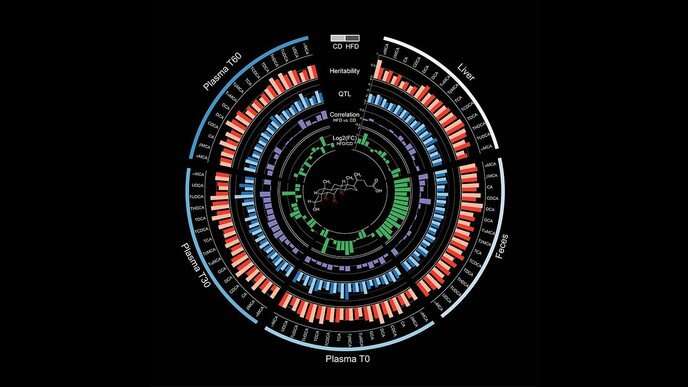Genetics and diet influence bile acid homeostasis

EPFL scientists have used a systems genetics approach to unravel novel genetic and environmental modulators of bile acid homeostasis. Their findings provide new insights into the regulatory mechanisms of bile acid homeostasis and may have implications for the treatment of metabolic diseases.
Bile acids are a large group of cholesterol derivatives that are well known for their role in facilitating the intestinal absorption of fats. Once re-absorbed from the intestine,bile acidscirculate in the blood, where they can function as powerful hormones. The concentration and composition of bile acids in the blood change after each meal and this allows them to inform other organs that energy is available.
Despite this knowledge about their function, the genetic and environmental modulators of bile acids are not fully deciphered and the understanding of how specific bile acid entities are produced and function is lacking.
In a new study carried out by the groups of Kristina Schoonjans and Johan Auwerx at EPFL, with colleagues at UNIL and ETHZ, researchers used a "genetic reference population" of mice (the BXDs), which resemble the genetic variation of a small human population to gain new insights into bile acid homeostasis. By combiningenvironmental changes(high-fat diet feeding), "omics" data, bioinformatics, andmolecular biologyanalyses the team mapped hundreds of potential genetic and environmental determinants of bile acids, defining their impact on health and disease. The study is published inCell Metabolism.
The researchers also measured the abundance and composition of bile acids in the liver, stool, and plasma (the main tissues of bile acid synthesis, metabolism, and signaling, respectively) in 36 BXD mouse strains fed normal chow orhigh-fat diet. The data showed that bile acid levels were highly influenced by the diet.
Bile acids play a critical role in metabolic diseases, and the researchers confirmed that they strongly correlate with physiological traits, including body weight, fat mass, glucose, and insulin levels. They also identified several genetic loci linked to bile acid levels, with tauro-ursodeoxycholic acid (TUDCA) being the most prominent example. TUDCA is known to alleviate multiple diseases, but its receptor and modulators remain unknown. The scientists identified carboxylesterase 1C (CES1C) as a novel modulator of TUDCA plasma levels through bioinformatics and systems genetics approaches, and further validated its role using an in vivo loss-of-function mouse model.
“BXD鼠标参考人口是一个完美的model to study the genetic basis of complex traits and allows for the establishment of a controlled environment, a key prerequisite to this analysis," says Hao Li, the first author of the study. "This approach allowed us to identify CES1C as a modulator of TUDCA plasma levels and to discover many other links between genes, bile acids, and phenotypes," adds co-first author Alessia Perino. "This work, largely sponsored by the Kristian Gerhard Jebsen Foundation, lays the basis for the identification of novel approaches to increase health-promoting bile acids, which could pave the way for the development of promising therapies for human metabolic diseases."
Explore further


















